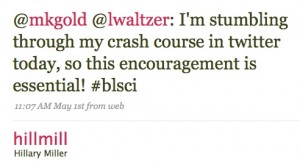This blog post is my application for one of the travel scholarships to OpenEd 2009. Here’s how the prompt goes:
- What you would “bring” to the conference? What can you contribute, be it a willingness to volunteer to moderate a session, some special expertise or project, an already accepted proposal…
- What you see as the most critical issue facing you in your efforts around Open Education, and how you think the conference can help you address it?
I approach the subject of Open Education from two different angles. The first angle is a humanist one. I’m trained as an academic: I’m doing my doctoral studies in philosophy at the CUNY Graduate Center. This academic training fuels an interest in education, and especially the way that education might (or must) move toward openness as time passes. The second angle is a technical one. I’m (in the process of becoming) a coder and developer of web applications. Working primarily with open source applications like Wordpress, Mediawiki and Drupal, I’m developing an increasing sense of the user-empowering potential of open source software. These two angles on openness converge in my career in various ways, both in my day job as an instructional technologist at Queens College and as a developer for the CUNY Academic Commons.
As such, I think I could bring to OpenEd 2009 an interesting perspective on the nature of openness. As a user of – and contributor to – open source products, I can speak confidently to the community benefits that emerge when powerful tools are developed in an open way. And, more specifically, as someone who has used these tools toward both educational purposes (for example, in support of blogging initiatives both in my classes and in the classes of others) as well as in more broadly scholarly contexts (like the community of collaborative research that the CUNY Academic Commons is designed to foster), I have a concrete sense of the way in which openness in one realm – the realm of software – can foster and feed another kind of openness in the educational realm.
In service of these (somewhat abstract!) goals, I’m willing to participate in as many concrete ways as possible at the conference. I’m an active and energetic Twitter backchannel user (see, for example, the Twitter conversations I took part in at this year’s THATCamp, as well as my previous musings on the role of Twitter at conferences). In discussions both on and off Twitter, I can offer up experience both theoretical (I am a philosopher, after all) and practical (I’m also a geek). I’d also be happy to moderate a panel, if I were asked to do so.
As for what the conference will do for me, I envision that my attendance at OpenEd 2009 would help me to further bridge the gap between the practical and the technical that characterizes so many of the things I do in my career. As an instructional technologist, I think it can be easy to think of yourself as a purveyor and teacher of tools, tools that merely replicate the kinds of learning that have always happened in classrooms. This, after all, is often the path of least resistance. The challenge, I believe, is empower faculty members (and, ultimately, the students themselves) not only to use technology but to understand the extent to which it shapes the world and, by extension, ourselves; only by appreciating this can an individual engage with the technology in such a way that it expands (rather than controls) his or her humanity. Openness is the linchpin: students cannot make the connection between what happens in a class and what happens in the rest of their lives unless the window between the two is open. So I guess my goal is to see what kinds of practical approaches are being taken by people in positions similar to mine, in order to help faculty and students understand how they can empower themselves by embracing openness.



